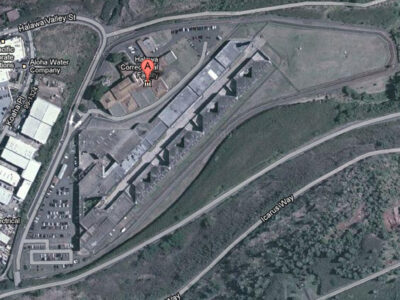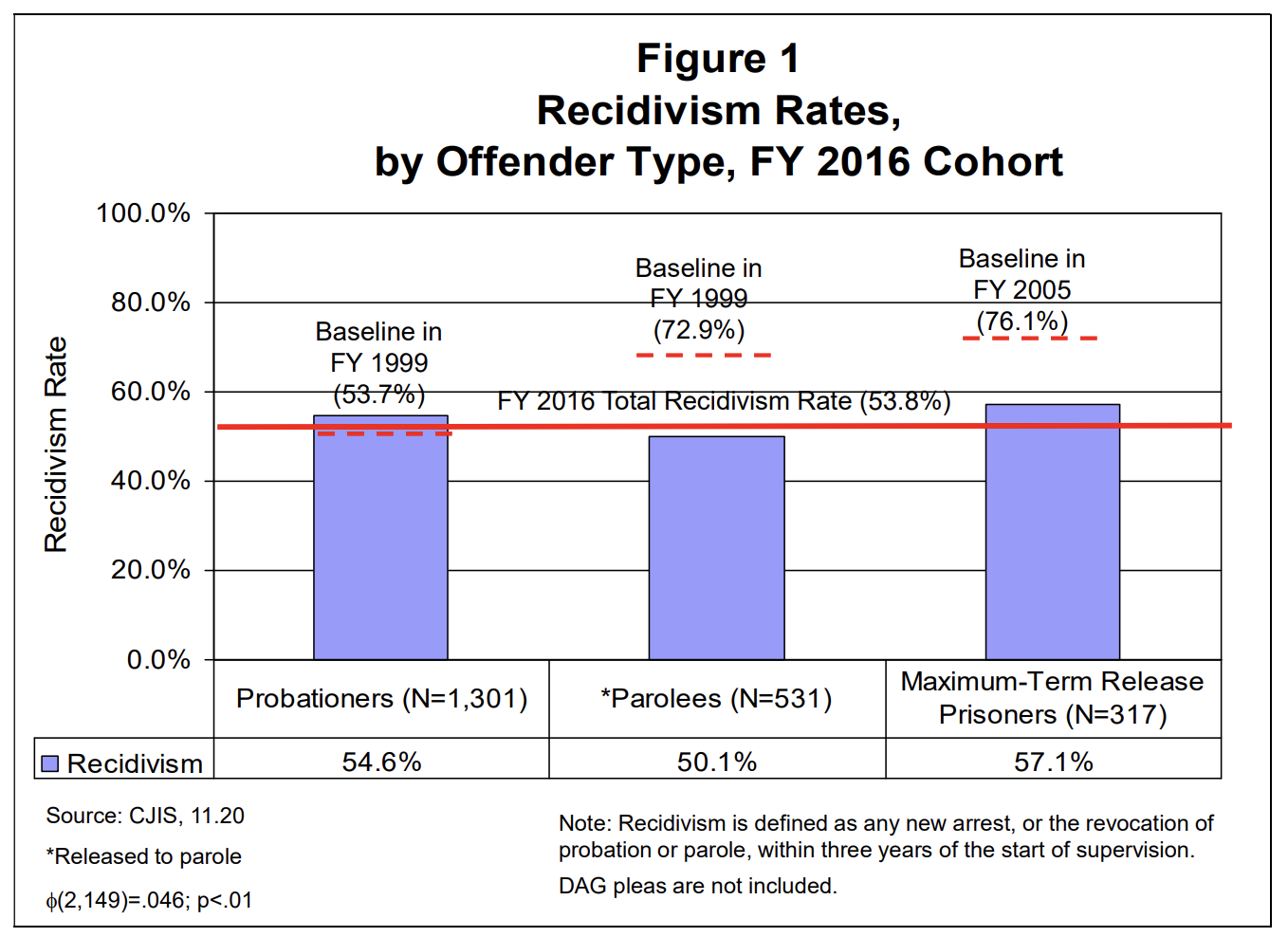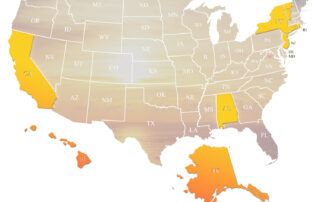
Criminal Justice in Hawaii
An island state and about 2,500 miles from the mainland U.S., one can safely surmise that Hawaii’s criminal justice system will be somewhat different from other states. This page offers a brief and concise summary of crime and criminal justice in the Aloha State, focusing on what areas of the state’s approach work and which could be improved.
Hawaii Prison Population Data
Understanding Hawaii’s criminal justice approach begins with answering key questions: How many people are incarcerated in Hawaii? What are the biggest prisons in Hawaii? How does Hawaii’s incarceration rate compare to other states?
Hawaii ranks 41st in the nation for incarceration, meaning only nine states incarcerate fewer people as a percentage of the population than Hawaii.1 Hawaii is behind New York in per capita incarceration but ahead of New Jersey. Hawaii has a comparatively low incarceration rate, yet there is significant racial disparity in its incarceration.2 For example, only 10% of the island’s state population are Indigenous Hawaiians, yet they comprise at least 39% of the state’s prison population.
According to 2019 National Institute of Corrections data, Hawaii operates a Unified System, meaning its state-level jails and prisons are integrated.3 That’s common practice among low-population states, with Alaska, Connecticut, Delaware, Rhode Island, and Vermont all utilizing similar systems. In 2019, Hawaii incarcerated 3,037 people in its eight-state jail/prison facilities. The state operates a criminal justice budget of $2,266,358; the state’s seventh costliest budget item.4
Hawaii also operates a Community Corrections system. In that system, 19,619 individuals are under probation, and 1,666 are under parole.
Hawaii’s incarceration rate is 215 per 100,000, and its violent crime rate is 286 per 100,000. The state’s property crime rate is 2,841. Hawaii spends approximately $72,270 per prisoner yearly, significantly higher than the national average.

Though Hawaii only has eight state-managed prisons and jails, the state also relies heavily on private prisons. Not only that, but most of these prisons are on the mainland. According to one report by the Hawaiian Attorney General’s office, about 54% of incarcerated Hawaiians are sent off the island to serve a sentence in a private prison on the mainland. This practice is undoubtedly more expensive than rehabilitating those Hawaiians on the island either in state prisons or through alternatives to incarceration.5
The Hawaii Correctional Facility (also called the Halawa Correctional Facility) is the state’s largest prison. It was opened in 1977, expanded in 1987, and remains the largest prison on the islands today. It can house up to 1,900 inmates.6
Crime and Recidivism in Hawaii
Multiple organizations have documented Hawaii’s crime rates, helpful metrics that outline the condition of crime, and criminal justice in Hawaii. According to Hawaii’s Office for Crime Prevention and Justice Assistance Division:7

- Hawaii reports about 44,324 crimes per year or 3,130 offenses per 100,000 population.
- Per 2019 data, crime is going down in Hawaii. The 2019 crime rate was about 0.3% lower than the 2018 crime rate and 14.5% lower than the 2010 crime rate.
- There were 3,782 violent crimes in Hawaii in 2019 or about 267 violent crimes per 100,000. This figure is significantly lower than the national average of 366.7 violent crimes per 100,000 Americans. Both the national violent crime rate and the Hawaiian violent crime rate have been declining in recent years.8
- Conversely, Hawaii reports a relatively high property crime rate, with 40,542 total property crimes indicating 2,863 property crimes for every 100,000 people in Hawaii. This rate is also declining in Hawaii.
- Nationally, about 2,130 property crimes per 100,000 people occur in the United States, a significantly lower property crime rate than in Hawaii.
Perhaps the clearest look at a state’s criminal justice system’s success (or lack thereof) is to examine statistical data on recidivism. According to the Bureau of Justice Assistance (a branch of the U.S. Department of Justice), Hawaii’s recidivism rate is 52.1%, meaning Hawaii’s criminal justice system is not working for more than half of the individuals who go through it.9
This information is corroborated by Hawaii-based research and data-finding. To that point, the Judiciary of the State of Hawaii, the State Attorney General, the Public Safety Department, and the Hawaii State Department of Health all collaborated on a bold plan to reduce recidivism in the state by 30%. The program ran from 2002 to 2018, and though it was unsuccessful in reaching its goal, it was able to categorize and document areas where policymakers could improve upon Hawaii’s criminal justice system. Recidivism rates in Hawaii have swung back and forth, between a low of 53% and a high of 76%.10

Criminal Reform in Hawaii and Alternatives to Incarceration
Criminal rehabilitation in Hawaii has proven to be somewhat successful, though there is room for improvement. The Hawaii criminal justice system uses numerous rehabilitative tools within prisons. These tools aim to restore an individual’s ability to live without resorting to crime as a coping mechanism for dealing with life’s challenges. For example, the state operates a comprehensive drug court program that helps nonviolent offenders serving drug-related sentences overcome their drug habits. Hawaii also utilizes family court programs, which address family-related crimes, like domestic violence and juvenile crimes. Examples of such programs include:11
- Home Maluhia
- Project Visitation
- Ho’okele Program
- Kids First Program
- Family Drug Court
- Hawai`i Girls Court
- Zero to Three Court
- Juvenile Drug Court
- Court Appointed Special Advocates
- Ho’olōkāhi Parent Facilitator Program
- O’ahu Child Welfare Mediation Program
- Hale Ho’omalu Juvenile Detention Facility
- Juvenile Client Services, Juvenile Specialized Services Section
- Juvenile Client Services, Juvenile Intake and Probation Section
Policymakers should also consider alternatives to prison in Hawaii. And for those offenders who the state must incarcerate, the state should implement educational programs inside prisons in Hawaii and rehabilitation programs inside prisons in Hawaii.
One of the main stumbling blocks in Hawaii’s criminal justice system is that the system overwhelmingly incarcerates Hawaiians for nonviolent property crimes or drug-related offenses. Rather than utilizing other correction methodologies such as drug court, family court, probation, community service, work programs, house arrest, educational programs, volunteer activities, etc.
Further, Hawaii’s criminal justice system disproportionately affects Indigenous Hawaiians, suggesting a racial factor in the state’s criminal justice program. For example, Native Hawaiians are more likely than non-Native Hawaiians to receive a prison sentence than a probation sentence.12
A system that places people in prison for long periods for crimes that the state could potentially address through alternatives is not ideal because research shows that increased exposure to the criminal justice system is linked to higher recidivism rates, thus creating a vicious cycle of self-defeating and ongoing incarceration.
Criminal Reform is Possible
The Hawaiian criminal justice system should implement more alternatives to incarceration. The state should implement educational programs for those who must be incarcerated so inmates can experience true rehabilitation. Criminal reform in Hawaii is possible, but it will involve focusing on public safety and helping and rehabilitating the people who commit crimes.
Sources:
- BJS. “Prisoners in 2020 – Statistical Tables.” Bureau of Justice Statistics, 2021. bjs.ojp.gov
- PPI. “Hawaii Profile.” Prison Policy Institute, 2022. prisonpolicy.org
- NIC. “Hawaii 2019.” National Institute of Corrections, 2019. nicic.gov
- Urban. “Project Hawaii.” Urban Institute, 2022. urban.org
- Hawaii AG. “Hawaii’s Imprisonment Policy and the Performance of Parolees Who Were Incarcerated In-State and on the Mainland.” Hawaii Attorney General, 2011. ag.hawaii.gov
- DPS. “Halawa Correctional Facility.” State of Hawaii Department of Public Safety, 2022. dps.hawaii.gov
- DPS. “Crime in Hawaii.” State of Hawaii Department of Public Safety, 2021. dps.hawaii.gov
- FBI. “Crime in the United States.” Federal Bureau of Investigation, 2019. ucr.fbi.gov
- BJA. “State Criminal Justice Profile.” Bureau of Justice Assistance, 2014. bjafactsheets.iir.com
- ICIS. “2019 Recidivism Update.” Interagency Council on Intermediate Sanctions, 2019. icis.hawaii.gov
- HSJ. “Family Court Programs.” Hawaii State Judiciary, 2022. courts.state.hi.us
- OHA. “The Impact of the Criminal Justice System on Native Hawaiians.” Office of Hawaiian Affairs, 2022. oha.org
Related Articles
Nine States Have Reduced Their Prisoner Population by 30%. What Do They Have in Common?
For the first time in decades, several U.S. states are making a concerted effort to reduce their prison populations by applying a range of policy...
Read more >>
What Is the Scope of Private Prisons in the U.S.?
In 2001, the Federal Bureau of Justice Assistance authored a report analyzing then-emergent issues regarding private prisons in the United States. According to the authors...
Read more >>
Success Overcoming Addiction Course
I have benefited greatly from this course and given me a better understanding of various drugs, the effects and how to deal with addiction. For...
Read more >>
Success – E.R.
I really enjoyed this course because I was always under the impression that graphs and statistics could only be used in the business workplace. Now...
Read more >>





